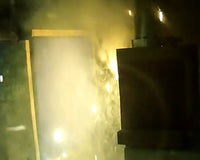Arc flash, a sudden release of electrical energy, can have devastating consequences, not only in terms of physical harm but also on the emotional and psychological well-being of individuals who experience it.
We have collaborated with and supported many arc flash survivors on their road to recovery and although the instant impact and damage an arc flash is fatal, there are many ore long term effects which aren’t widely discussed.
Continue reading as in this blog, we will look into the medical side of arc flash, exploring the reasons behind its harmful nature and the lasting complications it can cause for those engineers who have experienced it, starting with why an Arc Flash is so harmful.
Why is an Arc Flash so harmful?
An arc flash is a sudden and explosive release of electrical energy caused by a fault or short circuit in an electrical system. This occurs when electric current flows through the air between conductors or from a conductor to a grounded surface. The discharge produces intense heat, blinding light, and a shockwave, resulting in a potentially hazardous and life-threatening situation.
What can happen to a human in an Arc Flash?
Here are a few key aspects of arc flashes and the problems they can cause to engineers:
- Extreme Temperatures: During an arc flash, temperatures can reach as high as 35,000 degrees Fahrenheit (19,426 degrees Celsius). This extreme heat can cause severe burns to anyone near the event.
- Intense Light and Sound: The release of energy generates an intense flash of light and a loud noise, which can lead to sensory overload for individuals in the vicinity
Q: Can an arc flash blind you?
A: The intense light can cause temporary or permanent blindness from the ultraviolet light of the flash.
- Pressure Wave and Blast Effects: The rapid expansion of air during an arc flash creates a pressure wave and blast effects. This can result in physical injuries such as concussions, fractures, and blunt force trauma to individuals within the blast radius.
- Explosive Release of Molten Metal: The extreme temperatures can cause metal conductors and equipment to vaporise, creating a plume of molten metal particles. These particles can cause severe burns and ignite flammable materials in the surrounding area.
Likelihood of Surviving an Arc Flash?
Surviving an arc flash is within the realm of possibility, yet the severity of injuries can fluctuate greatly depending on multiple factors. The key to increasing survival rates and reducing long-term repercussions lies in quick medical intervention. Equally important is the enforcing of effective personal protective equipment (PPE) and strict adherence to safety protocols prior to engaging work.
Those acquainted with the electrical services industry are familiar with the risks posed by arc flash incidents, with statistics indicating that approximately 40% of such occurrences prove fatal.
What Percentage of Electrical Injuries are a Result of an Arc Flash?
Electrocution emerges as the fifth leading cause of fatalities in the United States, according to an online study. Alarmingly, one to two lives are lost each day in North America due to arc flash incidents. The reality is that a staggering 97% of electricians have experienced shocks or injuries on the job, emphasising the inherent risks in the electrical sector.
Have many people been injured and died from Arc Flash?
According to a report published in Industrial Safety and Hygiene News, estimated an average of 30,000 arc flash incidents annually, although the specific location is undisclosed. The gravity of these incidents becomes even more apparent when considering the associated consequences: an annual average of 7,000 burn injuries, 2,000 hospitalisations, and 400 fatalities.
How Often Does an Arc Flash Survivor Regain Their Past Quality of Life?
The journey to recovery for arc flash survivors is unique to each individual and depends on the severity of injuries sustained. Outside of the physical injuries caused by what we mentioned above, there some longer lasting effects which are not spoken about as much yet are equally important as they relate to the engineer’s future post arc flash event.
Post-Traumatic Stress Disorder (PTSD) - Whilst experiencing some sort of post-traumatic response after being involved in an arc flash incident is completely normal, where it starts to become problematic is when it begins having an impact on a person’s ability to perform ordinary day-to-day tasks or stops them from being able to return to work.
Where PTSD presents itself, it is important that the individual receives treatment for it. Where help is not given, it often results in the disorder becoming much more severe and has the potential to negatively impact upon both personal and professional relationships.
Depression / Anxiety - A diagnosis of PTSD commonly coincides with a diagnosis of depression / anxiety also. In fact, PTSD is characterised by symptoms of anxiety, flashbacks, and reliving traumatic experiences. Depression, however, is characterised by low moods, loss of interest and pleasure, and changes in energy levels. Just like PTSD, depression too is a common response after experiencing a traumatic or stressful events, so it is perhaps not surprising then that these two conditions can and do occur at the same time.
Loss of Income - It often becomes the case that because, the individual is no longer able to provide financially for their family, that they develop a sense of worthlessness – because of this they withdraw themselves from participating in family events. If not being able to earn an income continues for an extended period, then the person and their family may begin to face financial hardship.
In conclusion, the medical side of arc flash incidents goes beyond the immediate physical harm, looking into lasting complications that impact the emotional and psychological well-being of survivors.
Surviving an arc flash is possible, but the road to recovery is multifaceted. Beyond physical injuries, there are often overlooked consequences that affect an engineer's post-arc flash life, such as post-traumatic stress disorder (PTSD), depression, anxiety, and the potential loss of income.
As a community, it is crucial to recognise and address the holistic impact of arc flash incidents. Increased awareness, comprehensive support systems, and accessible mental health resources are essential components in helping survivors regain their quality of life.




